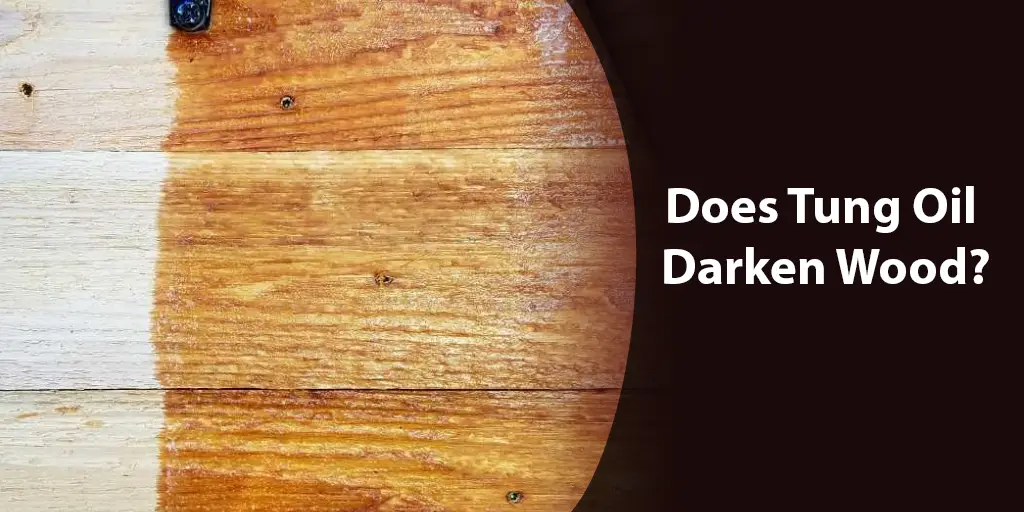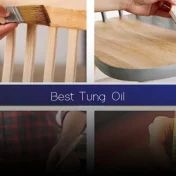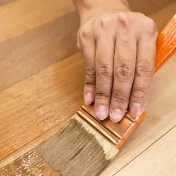Whether you’re just starting out in woodworking or an experienced craftsman looking to expand your skills, properly finishing your projects is key to achieving beautiful, long-lasting results.
One of the most popular and versatile wood finishes on the market for both protection and aesthetic purposes is tung oil.

With its reputation for bringing out the natural beauty in woodgrains while providing moisture resistance, it’s no wonder it has become a staple product in workshops everywhere.
However, like any finish, tung oil has its nuances that are important to understand in order to get the appearance you want.
One frequent question among woodworkers is how the application of tung oil will affect the color of different wood types.
While tung oil is known for accentuating the natural hues in wood, will it darken or lighten the overall shade? The answer depends on the specific properties and formulation of the tung oil product used.
We’ll explore in detail how pure tung oil versus dark tung oil with additives will interact with light or dark wood. We’ll also provide tips on customizing your desired hue through tinting techniques. You’ll learn how the number of coats and drying time factors into any color changes.
Does Tung Oil Change the Color of Wood?
When it comes to how tung oil affects the natural hue of wood, it’s important to distinguish between pure tung oil and products labeled as “dark tung oil”.
Pure tung oil, as the name suggests, contains nothing added beyond the raw tung oil extract from the tung tree nuts.
Dark tung oil, on the other hand, has additional components mixed in that can significantly impact its coloring properties.
Let’s break down exactly what happens when each type is applied to various wood surfaces:
Pure Tung Oil
With its faint natural amber/honey pigment, pure tung oil brings out the inherent character in woodgrains without drastically altering the base color.
It imparts a subtle warm glow that enhances rather than overpowers lighter woods like maple or birch.
Applied to darker woods such as walnut or mahogany, you’ll see little change besides a softened appearance. The finish accentuates without darkening.
Dark Tung Oil
Formulations labeled as dark contain microscopic particulate pigments added into the drying oil. These integrated colorants are what provide the deeper brownish hue.
When used on pale wood like pine, expect it to take on tones resembling a richer wood like mahogany. Applied liberally, it can transform the look entirely.
On woods already displaying darker tones, the change is less dramatic but still creates depth and emphasis.
Understanding how raw tung oil maintains integrity while dark versions insert pigments empowers you to choose products that enable rather than undermine your artistic vision. Let the grain speak for itself or deepen expression – the choice is yours.
Does Tung Oil Get Darker with Multiple Coats?
Now that we’ve explored how the color of tung oil impacts wood on initial application, the next logical question is – what happens with repeated coats? Does the hue intensify or remain consistent as multiple finishing layers are added?
Once again, there is a distinction between raw and dark varieties:
Pure Tung Oil
Don’t expect drastic shifts in shade even with 5 or more pure oil coats. The warm amber tone may deepen to some degree, but it will not transform dramatically darker the more it’s applied.
Over-layering also runs the risk of the finish becoming built up rather than absorbing – better to allow for proper curing between passes.
Dark Tung Oil
Here the pigment-infused formula behaves differently, getting noticeably richer and darker with each additional coat worked into the grain.
This allows for better control over how much color depth is achieved. For staining a light wood to a deep espresso shade or accentuating a reddish hue in cherry, multiple thin applications may be preferable to one or two thicker ones.
Proper technique is still key – allow optimal drying time between coats as indicated by the product instructions.
But dark tung oil provides an avenue for woodworkers who want to deepen expression through layering versus a single pass of color. Matching application quantity to your specific goals ensures beautiful, long-lasting results.
By understanding these distinctions, you can harness the unique properties of pure versus dark tung oil to either preserve or intensify the natural character of any wood surface for your project.
What Color is Tung Oil?
With the effects of multiple coats now clear, it’s important to understand the base color characteristics of pure versus dark tung oil. What natural shades can you expect from each variety out of the tin?
Let’s break it down:
Pure Tung Oil
Drawing from the golden brown color of raw tung nuts, pure tung oil possesses a very mild honey or amber pigment. It presents as transparent rather than opaque, allowing the wood’s undertones to shine through.
The tint is described as ‘faint’—enough to subtly gild without distraction from the grain pattern. This near-invisible touch enhances natural beauty.
Dark Tung Oil
To earn the moniker ‘dark’, these formulations obviously differ significantly in color composition. Ranging in hue from rich chocolate to a deep mahogany red tone depending on brand, these oils owe their darkness to added particulates.
Complex hydrocarbon byproducts and specialty pigments morph the base oil into solid shades meant for significant coloring impact.
Being aware of the inherent lightness or darkness of pure versus dark varieties ensures choosing the right product match for your project goals upfront.
While pure tung accentuates with a light hand, dark varieties pack bold pigment suited when dramatic shifts are required.
Confident identification of the starting color profile simplifies selecting options suitable to achieve your unique vision.
Considerations such as wood type, desired mood and appropriate contrasts in hue are also factors—but understanding the foundational color attributes of each product category is a wise starting point for woodworkers.
Does Tung Oil Look Good on Any Wood Type?
When it comes to maximizing the natural beauty of wood through finishing, tung oil truly excels across the board regardless of genus or hue.
But what is it about this versatile drying oil that allows it to flatter even the most challenging woodgrains?
Tung oil’s unique ability to penetrate deeply aids its supremacy. Where other finishes may sit too thickly on the surface, impeding definition, tung soaks into every nook and plane like a gentle compressive force. This allows for unparalleled revelation of texture and swirling patterns below.
Another advantage is bringing uniformity to variegated woods through a unifying saturation of color. Whether median strips in oak or shifts in mahogany, a tung finish stabilizes tones into a harmonious whole.
Yet this flattering effect never overrides individuality—each new slope and whorl remains prominently visible.
Even difficult-to-work grain structures like curly maple pose no obstacle, as tung slips into tight curves with ease. The result still dazzles the eye with an energetic optical play instead of a muddled impression.
While it works wonders emphasizing richness in juicy fruitwoods like cherry, tung also energizes neutral palettes like ash or walnut with subtle warming highlights. And revealing hidden depths in exotics like ebony would not be possible without its finishing grace.
Truly, there is no woodgrain too intricate or hue too light or dark to be enhanced under the kiss of tung oil. Its ability to merge enhancement with preservation of natural character ranks it among the most versatile of woodworking allies.
Read Also: Does Oak Stain Well?
Can You Tint Tung Oil?
While tung oil’s natural binding properties make it ideal for protecting wood fibers, its inherent transparent amber tone is not always the perfect pigment match for a project.
Fortunately, woodworkers can customize beyond tung oil’s basic tone through tested tinting techniques.
A popular method utilizes oil-based stains designed for blending. These penetrate matching pigments without hindering tung’s absorption.
When selecting stains, consider drying time similarity to avoid half-curing issues. Slow-drying varieties fare best.
Stain quantity impacts outcome, so start gradually—a few drops at a time mixed into tung oil until achieving the preferred hue.
Test swatches allow evaluating dry results before proceeding with entire projects. With patience, nuanced earthtone shades emerge.
Alternatively, gel-based stains may be applied on cured tung oil. Gels sit decoratively rather than bonding chemically like regular stain.
After tung fully hardens the wood surface over 4 weeks, gel stain paintings infuse bold extra color for a heightened look.
SYPs MastersTouch oil stains offer wood-matching fusions. A few drops in tung oil bring out buttery undertones in ash or energize cherry’s vibrancy. Bear exotic shares muted red shades perfecting ebony.
With methods exploring tung oil’s compatibility alongside complementary pigments, woodworkers achieve bespoke complexions for spectacular personalized pieces. Understanding ingredient chemistry produces repeatable artistry.
Does Tung Oil Leave a Shine?
When crafting a finish, the balance between protection and aesthetic is delicate.
While UV shielding is crucial for wood’s well-being, an overly glossy or matte texture can clash with a piece’s natural warmth. Determining tung oil’s sheen properties is therefore key for style success.
Pure tung oil produces a softly muted, non-reflective fare that allows wood’s inner radiance to glow naturally. Its molecules synchronize completely with the grain, leaving no artificial barrier separating eye from essence.
This isn’t to say carbonized souls cannot find satisfaction – certain “tung oil” blends infuse auxiliary polyurethane resins augmenting durability at the cost of subtlety.
Beware misleading labels, as these concoctions introduce shine that may overwhelm delicate undertones.
For a balanced middle path, small amounts of polyurethane can enhance weather resistance without disrupting tung oil’s soulful non-glare. Lighter applications allow guarded radiance instead of a slick superficial patina.
Proper preparation also influences final satin presence – a single wiped coat versus rigorous buffing impacts perception. Let smoother blanks shine without force while embracing character in gnarled veterans.
A choice respects wood’s romanticism, avoiding both extremes. Find harmony through familiarizing outer glow desires and tung oil’s wise equilibrium keeping inner beauty comfortably bare. Let the essence speak freely in its natural semi-matte visual language.
Can Tung Oil Turn Wood Yellow?
Often the mark of a finish’s failure is an unattractive shift toward sickly hues—a nightmare for those striving for a heirloom creation. Woodworkers rightly demand materials upholding dignity with flying colors through the ages.
Does tung oil warrant trust in this department, or should its reputation face a taint of yellow? Let’s drill down to the scientific core beneath sensationalism.
Pure tung oil’s non-pigmented composition precludes inherent dye tendencies. Composed solely of naturally polymerized fatty acids, it acts transparently without introducing artificial chroma.
However, some call “tung oil” blends come under suspicion. While extending work life, additives like amber-prone alkyd or phenolic resins pose long-term chroma risks under UV assault through unstable chemical bonds.
To avoid corrupted perceptions, purchase genuine raw tung oil and shun synthetic “upgrades” needlessly jeopardizing nature’s harmonious design. Proper common-sense UV protection further supports permanent good looks
With facts over feelings, woodworkers gain confidence directing creative vision on steady ground.
Pure tung oil should stand acquitted of yellowing charges while pseudo versions face serious indictment. Clarity filters perception keeping craft elevated by principles protecting wood’s dignity as a living art medium.
Conclusion
When seeking to honor the innate warmth and texture of wood, few mediums empower artistic expression like pure tung oil.
As we’ve explored through examining its interaction with various wood tones, tinting techniques, and protective qualities, this versatile drying agent is a crafter’s most valued ally.
Whether accentuating subtle grain architecture or saturating for dramatic chromatic shifts, tung oil’s unrivaled ability to merge seamlessly yet deeply with the wood fabric empowers unrealistic revelation.
Its welcoming of custom nuance through stabilized pigment blending further supports individualized mastery.
Most vital is tung oil’s faithfulness as a preserver of wood’s integrity. Free of suspicious synthetics threatening dignity through unwanted color corruption, it remains trustworthy for heirloom craftsmanship.
Armed with thorough understanding of tung oil’s science and versatile manipulation, woodworkers hold keys unlocking each material’s fullest potential.
Confidence emerges to elevate any project through maximizing intrinsic natural excellence. When wood’s voice rings clear,walls dissolve between artist and prized medium in shared expression.
Mastery utilizes rather than dominates or silences nature’s gifts. May tung oil, the partner enabling wood’s purest messages, ever continue empowering artistry that uplifts both craftsman and beholder in timeless harmony.



